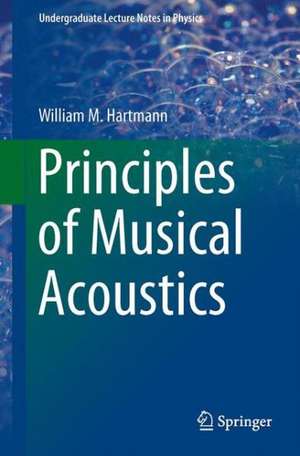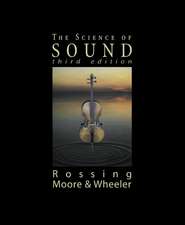Principles of Musical Acoustics: Undergraduate Lecture Notes in Physics
Autor William M. Hartmannen Limba Engleză Paperback – 26 iul 2013
The mathematical level of this book assumes that the reader is familiar with elementary algebra. Trigonometric functions, logarithms and powers also appear in the book, but computational techniques are included as these concepts are introduced, and there is further technical help in appendices.
Din seria Undergraduate Lecture Notes in Physics
- 17%
 Preț: 362.11 lei
Preț: 362.11 lei -
 Preț: 398.45 lei
Preț: 398.45 lei -
 Preț: 265.30 lei
Preț: 265.30 lei - 15%
 Preț: 478.05 lei
Preț: 478.05 lei -
 Preț: 371.85 lei
Preț: 371.85 lei - 17%
 Preț: 364.52 lei
Preț: 364.52 lei - 15%
 Preț: 620.25 lei
Preț: 620.25 lei - 17%
 Preț: 363.03 lei
Preț: 363.03 lei - 17%
 Preț: 427.77 lei
Preț: 427.77 lei -
 Preț: 493.12 lei
Preț: 493.12 lei - 18%
 Preț: 789.98 lei
Preț: 789.98 lei -
 Preț: 385.10 lei
Preț: 385.10 lei -
 Preț: 398.12 lei
Preț: 398.12 lei -
 Preț: 401.24 lei
Preț: 401.24 lei - 13%
 Preț: 358.33 lei
Preț: 358.33 lei - 17%
 Preț: 429.08 lei
Preț: 429.08 lei - 17%
 Preț: 362.93 lei
Preț: 362.93 lei -
 Preț: 472.29 lei
Preț: 472.29 lei - 17%
 Preț: 363.47 lei
Preț: 363.47 lei -
 Preț: 338.97 lei
Preț: 338.97 lei - 17%
 Preț: 364.56 lei
Preț: 364.56 lei - 20%
 Preț: 579.76 lei
Preț: 579.76 lei - 17%
 Preț: 365.68 lei
Preț: 365.68 lei - 17%
 Preț: 366.61 lei
Preț: 366.61 lei - 17%
 Preț: 432.41 lei
Preț: 432.41 lei -
 Preț: 372.36 lei
Preț: 372.36 lei -
 Preț: 359.53 lei
Preț: 359.53 lei -
 Preț: 397.25 lei
Preț: 397.25 lei -
 Preț: 317.55 lei
Preț: 317.55 lei -
 Preț: 229.57 lei
Preț: 229.57 lei - 15%
 Preț: 538.28 lei
Preț: 538.28 lei -
 Preț: 468.02 lei
Preț: 468.02 lei -
 Preț: 428.07 lei
Preț: 428.07 lei -
 Preț: 637.07 lei
Preț: 637.07 lei -
 Preț: 582.65 lei
Preț: 582.65 lei -
 Preț: 424.77 lei
Preț: 424.77 lei -
 Preț: 446.96 lei
Preț: 446.96 lei - 15%
 Preț: 515.30 lei
Preț: 515.30 lei -
 Preț: 348.22 lei
Preț: 348.22 lei -
 Preț: 313.45 lei
Preț: 313.45 lei -
 Preț: 319.43 lei
Preț: 319.43 lei - 15%
 Preț: 509.58 lei
Preț: 509.58 lei - 15%
 Preț: 507.95 lei
Preț: 507.95 lei -
 Preț: 361.29 lei
Preț: 361.29 lei -
 Preț: 453.21 lei
Preț: 453.21 lei -
 Preț: 453.01 lei
Preț: 453.01 lei - 15%
 Preț: 722.67 lei
Preț: 722.67 lei -
 Preț: 392.21 lei
Preț: 392.21 lei -
 Preț: 383.71 lei
Preț: 383.71 lei
Preț: 425.20 lei
Nou
Puncte Express: 638
Preț estimativ în valută:
81.36€ • 85.18$ • 67.32£
81.36€ • 85.18$ • 67.32£
Carte tipărită la comandă
Livrare economică 08-22 aprilie
Preluare comenzi: 021 569.72.76
Specificații
ISBN-13: 9781461467854
ISBN-10: 1461467853
Pagini: 364
Ilustrații: XIV, 348 p. 180 illus.
Dimensiuni: 155 x 235 x 19 mm
Greutate: 0.51 kg
Ediția:2013
Editura: Springer
Colecția Springer
Seria Undergraduate Lecture Notes in Physics
Locul publicării:New York, NY, United States
ISBN-10: 1461467853
Pagini: 364
Ilustrații: XIV, 348 p. 180 illus.
Dimensiuni: 155 x 235 x 19 mm
Greutate: 0.51 kg
Ediția:2013
Editura: Springer
Colecția Springer
Seria Undergraduate Lecture Notes in Physics
Locul publicării:New York, NY, United States
Public țintă
Upper undergraduateCuprins
Sound, Music, and Science.- Vibrations 1.- Vibrations 2.- Instrumentation.- Sound Waves.- Wave Properties.- Standing Waves.- Standing Waves in Pipes.- Fourier Analysis and Synthesis.- Sound Intensity.- The Auditory System.- Loudness Perception.- Pitch.- Localization of Sound.- Sound Environments.- Audio Transducers.- Distortion and Noise.- Audio Systems.- Loudspeakers.- Digital Audio.- Broadcasting.- Speech.- Brass Musical Instruments.- Woodwind Instruments.- String Instruments.- Percussion Instruments.- Electronic Music.
Recenzii
From the book reviews:
“Principles of Musical Acoustics is a welcome addition to the existing selection of undergraduate texts. … the writing is clear and lively, and it would be accessible to its target audience. Coupled with a laboratory component and ample demonstrations and computer visualizations, it could form the basis for a stimulating semester course.” (John Smedley, Physics Today, September, 2014)
“Principles of Musical Acoustics is a welcome addition to the existing selection of undergraduate texts. … the writing is clear and lively, and it would be accessible to its target audience. Coupled with a laboratory component and ample demonstrations and computer visualizations, it could form the basis for a stimulating semester course.” (John Smedley, Physics Today, September, 2014)
Notă biografică
Prof. William Hartmann is Professor of Physics at Michigan State University. His research focuses on psychoacoustics and sound perception, and he first taught his course on musical acoustics for undergraduates in 1974.
In 1981-82 Dr. Hartmann took a leave of absence to work as a visiting scientist at the Institute for Research on Acoustics and Music (IRCAM) in Paris. He subsequently served at IRCAM as acting director of acoustics (1982-1983) and, supported by a NSF-CNRS grant, as consultant (1983-1987).
Dr. Hartmann has been a fellow of the Acoustical Society of America since 1983. He was chairman of the Technical Committee on Musical Acoustics from 1980 to 1984. From 1992-1995 he served on the Society's Executive Council and was chairman of the External Affairs Administrative Council (1994-1995). He gave the Society Tutorial at the spring meeting in 1996 entitled, "Pitch, Periodicity and the Brain." He served as vice president of the Society (1998-1999) and as president (2001-2002). As president, he worked to enhance the Society's connections with allied organizations such as the Institute for Noise Control Engineering, and to expand the Society's presence internationally.
In 2001 Dr. Hartmann received the Distinguished Faculty Award from Michigan State University and the Helmholtz-Rayleigh Silver Medal from the Acoustical Society of America. He currently serves as Editor-in-Chief of Springer's Modern Acoustics and Signal Processing Series.
In 1981-82 Dr. Hartmann took a leave of absence to work as a visiting scientist at the Institute for Research on Acoustics and Music (IRCAM) in Paris. He subsequently served at IRCAM as acting director of acoustics (1982-1983) and, supported by a NSF-CNRS grant, as consultant (1983-1987).
Dr. Hartmann has been a fellow of the Acoustical Society of America since 1983. He was chairman of the Technical Committee on Musical Acoustics from 1980 to 1984. From 1992-1995 he served on the Society's Executive Council and was chairman of the External Affairs Administrative Council (1994-1995). He gave the Society Tutorial at the spring meeting in 1996 entitled, "Pitch, Periodicity and the Brain." He served as vice president of the Society (1998-1999) and as president (2001-2002). As president, he worked to enhance the Society's connections with allied organizations such as the Institute for Noise Control Engineering, and to expand the Society's presence internationally.
In 2001 Dr. Hartmann received the Distinguished Faculty Award from Michigan State University and the Helmholtz-Rayleigh Silver Medal from the Acoustical Society of America. He currently serves as Editor-in-Chief of Springer's Modern Acoustics and Signal Processing Series.
Textul de pe ultima copertă
Principles of Musical Acoustics focuses on the basic principles in the science and technology of music. Musical examples and specific musical instruments demonstrate the principles. The book begins with a study of vibrations and waves, in that order. These topics constitute the basic physical properties of sound, one of two pillars supporting the science of musical acoustics. The second pillar is the human element, the physiological and psychological aspects of acoustical science. The perceptual topics include loudness, pitch, tone color, and localization of sound. With these two pillars in place, it is possible to go in a variety of directions. The book treats in turn, the topics of room acoustics, audio both analog and digital, broadcasting, and speech. It ends with chapters on the traditional musical instruments, organized by family.
The mathematical level of this book assumes that the reader is familiar with elementary algebra. Trigonometric functions, logarithms and powers also appear in the book, but computational techniques are included as these concepts are introduced, and there is further technical help in appendices.
The mathematical level of this book assumes that the reader is familiar with elementary algebra. Trigonometric functions, logarithms and powers also appear in the book, but computational techniques are included as these concepts are introduced, and there is further technical help in appendices.
Caracteristici
A concise musical acoustics book intended for undergraduates with a basic understanding of math and science Discusses both the physics of sound, and the psychology and physiology of how humans perceive sound and music Includes chapters on the tonal characteristics and physics of musical instruments Includes end of chapter exercises and solutions Appendices provide useful supplementary information on diverse topics such as standard piano tuning, the greek alphabet, notable composers, and trigonometric functions Written by the author of the classic text "Signals, Sound, and Sensation" Includes supplementary material: sn.pub/extras














